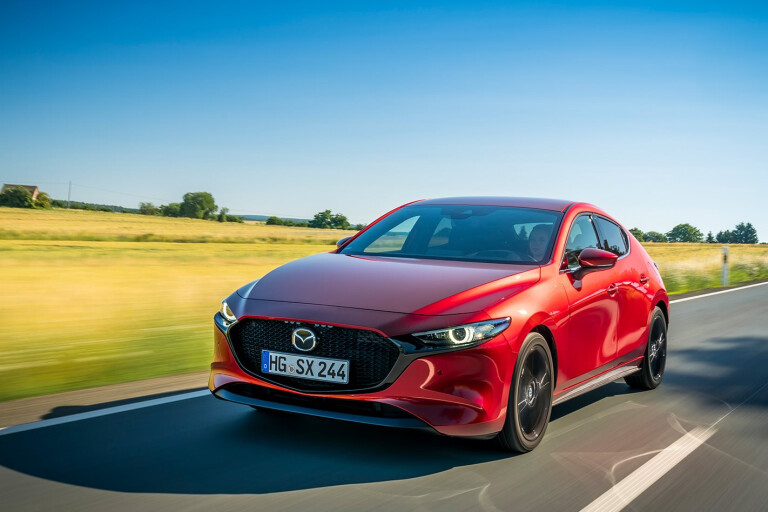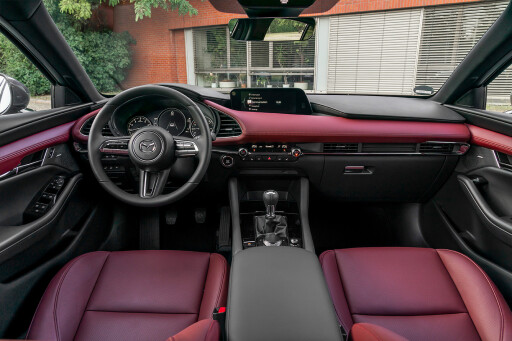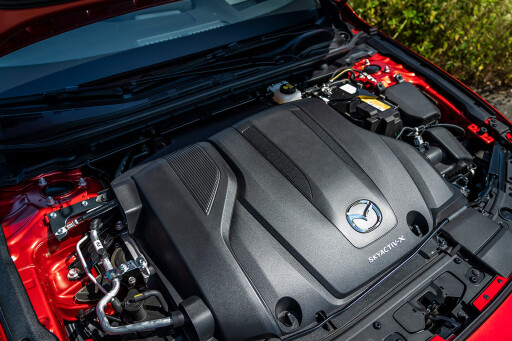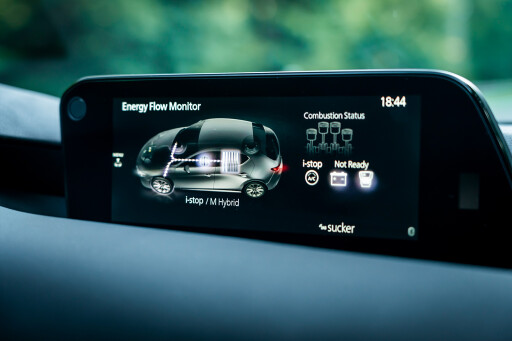
Things we like
- Engine innovation
- Mild hybrid smoothness
- Lovely manual transmission
Not so much
- High price
- Claustrophobic rear
- Does it quite make the economy numbers?
The Wheels Verdict: The Mazda 3 SkyActiv-X compression ignition petrol engine promised a revolution, so perhaps when it gets that huge billing it’s inevitable that the reality is a little more prosaic. Does it offer the economy of a diesel combined with the response of a petrol engine? Not quite, but it’s a big step towards that goal.
WHAT IS THE MAZDA 3 SKYACTIV-X?
You probably know the latest Mazda 3. We’ll save you the homework by stating that it’s good. Very good, in fact. But what had us really excited was the promise of this SkyActiv-X petrol engine. In simple terms, instead of using spark plugs like a normal petrol engine it uses compression to ignite the fuel, much like a diesel. Mazda promised diesel-like economy with petrol-style cleanliness and response. Sounds almost too good to be true, doesn’t it?
WHY WE’RE TESTING IT
We flew to the other side of the globe for just over 30km in a Mazda 3 SkyActiv-X, sampling both the manual and the automatic versions. An engine like this doesn’t come along every week, so it was more than worth the trip to Germany.

MAZDA 3 SKYACTIV-X REVIEW
YOU KNOW this stuff already, but it’s worth briefly reiterating. A petrol engine uses a spark plug to ignite the fuel/air mix in its cylinders whereas a diesel engine squashes that mix to the point that it spontaneously combusts. So far so conventional. What Mazda has done with its SkyActiv-X engine is a sort of technical voodoo that results in diesel-style compression ignition of petrol. So, Mazda claims, you get the best of both worlds: the high-rpm zing and clean exhaust emissions of a petrol engine combined with the low-end response and fuel economy of a diesel. It sounds too good to be true, doesn’t it? That’s what we thought too.
Then we drove Mazda’s Skyactiv-X prototype back in 2017 and, a few minor teething issues aside, the concept seemed to have legs. It’s now in production-ready guise plumbed beneath the bonnet of the voluptuous Mazda 3 and it’s clear that Hiroshima’s engineers haven’t been idle in the intervening period.

The biggest surprise is how normal this revolutionary technology seems. It doesn’t quite feel like 132kW at your disposal, but that’s about the only gripe. The 2.0-litre engine is supercharged and also features a 24v integrated starter generator and a Toshiba battery pack. The ISG not only fires the engine up quickly and with butter smoothness but, if you opt for the lovely manual transmission, it also gently keeps the revs up as you clutch in to finesse the gearchanges still further. Mature is the word I’d use to describe the feel of this engine. Mazda worked hard at improving the sound signature, fitting a sound absorbing capsule over the engine and filtering out atonal frequencies between the harmonic second, third and fourth orders.
Of course, the tech is brain-bendingly complex. Mercedes-Benz tried for years to crack the solution to compression-ignition with a petrol engine, but never managed to make the process stable. Mazda’s trick is to use a spark plug. As the piston comes up, there’s a spark that creates a small fireball that, in effect, acts as a second piston coming down, squashing the fuel air mix between until it goes bang. The control of the spark is the key to making the SkyActiv-X engine work.

So smooth is the 2.0-litre engine that you’ll often find yourself driving it at between 3000 and 4000rpm without the rounded-off granularity of its sound signature prompting you to upshift. Minus a turbocharger, there’s not that low end shove that turbodiesel buyers are accustomed to, the torque building in a linear fashion. Driven enthusiastically, we saw 7.5L/100km in the manual car, but when piloted in a more normal fashion on a very hilly test route, the six-speed automatic managed 6.2L/100km, this including a 170km/h autobahn section. Not quite diesel engine torque and economy then, but certainly nudging closer, Mazda claiming a 15-17 percent improvement over the conventional 2.0-litre SkyActiv-G lump. What’s more, NOx is well down on the SkyActiv-D diesel unit. It’s a lovely powerplant and one you could conceivably buy just for its refinement and response.

Much the same goes for the rest of the Mazda 3 package. Hiroshima has crafted a fine family hatch and the SkyActiv-X engine is the cherry on top. The issue that this engine faces is cost. It’ll be pitched as a high-end motor to Mazda customers who may not be particularly cost-sensitive regarding fuel savings. A few early adopters may be seduced by the tech – and it is indeed lovely in both concept and execution – but the Australian importers conservatively estimate it’ll make up less than five percent of the Mazda 3 product mix when it appears early next year. It will subsequently filter throughout Mazda’s range, first to CX-30 and then onwards into next-gen and not midlife facelift models, becoming more accessible in the process. For the time being at least, there remains a risk that 2020’s most technically intriguing powerplant could be relegated to a mere sideshow.

MAZDA 3 SKYACTIV-X VS RIVALS
Volkswagen Golf, Lexus CT200h, Peugeot 308
MAZDA 3 SKYACTIV-X PRICE AND SPECS
- Model: Mazda 3 SkyActiv-X
- Engine: 1998cc 4-cyl dohc turbo petrol
- Max power: 132kW @ 6000rpm
- Max torque: 224Nm @ 3000rpm
- Transmission: Six-speed manual
- 0-100km/h: 7.5s [est]
- Price: from $32,000 [est]
- On sale: Q1 2020
Things we like
- Engine innovation
- Mild hybrid smoothness
- Lovely manual transmission
Not so much
- High price
- Claustrophobic rear
- Does it quite make the economy numbers?



COMMENTS